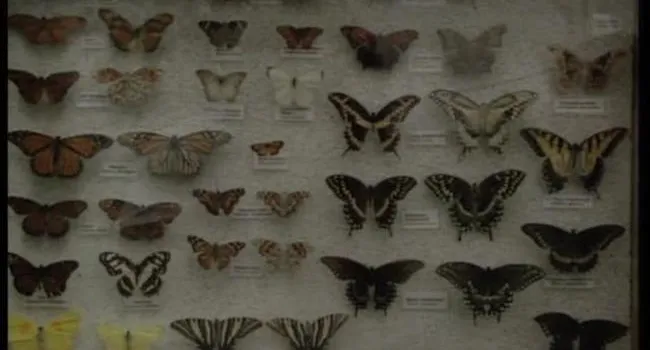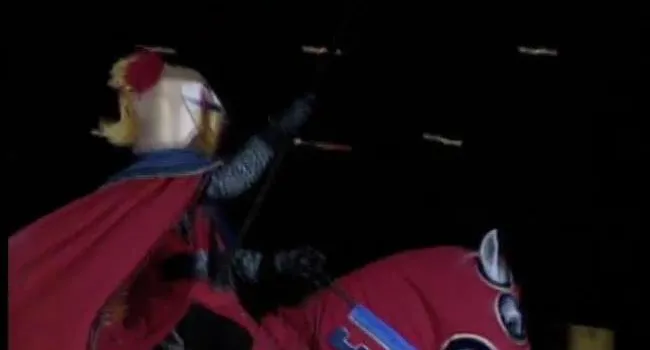When the Museum of York County had a special exhibit on snakes, the Project Discovery crew visited the exhibit with naturalist Rudy Mancke of PBS’s NatureScene. There are many myths about snakes, most of which are not true. Snakes have a three-chamber heart, a liver, and one lung, which is about threefourths of the length of the snake. The largest snake ever reported was an anaconda, which weighed 600 pounds. The longest snake reported was a python, which was 32 feet, nine and one-half inches long. The smallest snake reported was the thread snake, usually about three-fourths of an inch long.
Snakes continue to grow throughout their lives, shedding their skins as they grow -- usually about two or three times a year. The rattle on a rattlesnake is shed skin that never left the body.
Snakes have no eyelids, but they have clear scales over their eyes, that help protect them. These scales are shed with the skin. Snakes have no external ears. They sense vibrations by laying their heads on the ground and sensing the vibrations through their jawbones.
Although snakes do not have legs, some can move four to eight miles per hour. They cannot leap or outrun a person. Snakes actually walk on their ribs and pull themselves along, or they use belly scales to move forward, one scale at a time. Snakes are carnivorous and eat living materials such as rats, birds, eggs, other snakes, and toads. They eat five to six times their weight in food during the summer. When it is colder, they eat less and then they hibernate. Snakes have teeth that point down their throats, which help push the prey down the throat. Fanged snakes have large teeth that hinge and turn up in the mouth.
Copperheads and rattlesnakes are poisonous, or venomous, snakes. They have a triangular-shaped head because of the venom glands. The color of snakes and the pattern of the colors help identify snakes at a distance. There is a rhyme about identifying poisonous snakes: “Red touch yellow, kill a fellow; red touch black, venom lack.” Snakes are often camouflaged so that they can blend into the background. This helps them catch their prey and hide from predators.
Standards
- Life Science: Characteristics and Growth of Organisms
- 4.L.5 The student will demonstrate an understanding of how the structural characteristics and traits of plants and animals allow them to survive, grow, and reproduce.
- 4.L.5B Plants and animals have physical characteristics that allow them to receive information from the environment. Structural adaptations within groups of plants and animals allow them to better survive and reproduce.
- 4.L.5B.2 Construct explanations for how structural adaptations (such as the types of roots, stems, or leaves; color of flowers; or seed dispersal) allow plants to survive and reproduce.
- 4.L.5B.3 Construct explanations for how structural adaptations (such as methods for defense, locomotion, obtaining resources, or camouflage) allow animals to survive in the environment.
- 4.L.5B Plants and animals have physical characteristics that allow them to receive information from the environment. Structural adaptations within groups of plants and animals allow them to better survive and reproduce.
- 4.L.5 The student will demonstrate an understanding of how the structural characteristics and traits of plants and animals allow them to survive, grow, and reproduce.
- Life Science: Interdependent Relationships in Ecosystems
- 5.L.4 The student will demonstrate an understanding of relationships among biotic and abiotic factors within terrestrial and aquatic ecosystems.
- 5.L.4A Ecosystems are complex, interactive systems that include both the living components (biotic factors) and physical components (abiotic factors) of the environment. Ecosystems can be classified as either terrestrial (such as forests, wetlands, and...
- 5.L.4A.1 Analyze and interpret data to summarize the abiotic factors (including quantity of light and water, range of temperature, salinity, and soil composition) of different terrestrial ecosystems and aquatic ecosystems.
- 5.L.4A.2 Obtain and communicate information to describe and compare the biotic factors (including individual organisms, populations, and communities) of different terrestrial and aquatic ecosystems.
- 5.L.4B All organisms need energy to live and grow. Energy is obtained from food. The role an organism serves in an ecosystem can be described by the way in which it gets its energy. Energy is transferred within an ecosystem as organisms produce, consum...
- 5.L.4B.1 Analyze and interpret data to explain how organisms obtain their energy and classify an organisms as producers, consumers (including herbivore, carnivore, and omnivore), or decomposers (such as fungi and bacteria).
- 5.L.4B.3 Construct explanations for how organisms interact with each other in an ecosystem (including predators and prey, and parasites and hosts).
- 5.L.4B.4 Construct scientific arguments to explain how limiting factors (including food, water, space, and shelter) or a newly introduced organism can affect an ecosystem.
- 5.L.4A Ecosystems are complex, interactive systems that include both the living components (biotic factors) and physical components (abiotic factors) of the environment. Ecosystems can be classified as either terrestrial (such as forests, wetlands, and...
- 5.L.4 The student will demonstrate an understanding of relationships among biotic and abiotic factors within terrestrial and aquatic ecosystems.
- Life Science: Diversity of Life – Classification and Animals
- 6.L.4 The student will demonstrate an understanding of how scientists classify organisms and how the structures, processes, behaviors, and adaptations of animals allow them to survive.
- 6.L.4A Life is the quality that differentiates living things (organisms) from nonliving objects or those that were once living. All organisms are made up of cells, need food and water, a way to dispose of waste, and an environment in which they can liv...
- 6.L.4B The Animal Kingdom includes a diversity of organisms that have many characteristics in common. Classification of animals is based on structures that function in growth, reproduction, and survival. Animals have both structural and behavioral adap...
- 6.L.4B.1 Analyze and interpret data related to the diversity of animals to support claims that all animals (vertebrates and invertebrates) share common characteristics.
- 6.L.4B.2 Obtain and communicate information to explain how the structural adaptations and processes of animals allow for defense, movement, or resource obtainment.
- 6.L.4B.3 Construct explanations of how animal responses (including hibernation, migration, grouping, and courtship) to environmental stimuli allow them to survive and reproduce.
- 6.L.4B.4 Obtain and communicate information to compare and classify innate and learned behaviors in animals.
- 6.L.4B.5 Analyze and interpret data to compare how endothermic and ectothermic animals respond to changes in environmental temperature.
- 6.L.4 The student will demonstrate an understanding of how scientists classify organisms and how the structures, processes, behaviors, and adaptations of animals allow them to survive.




































